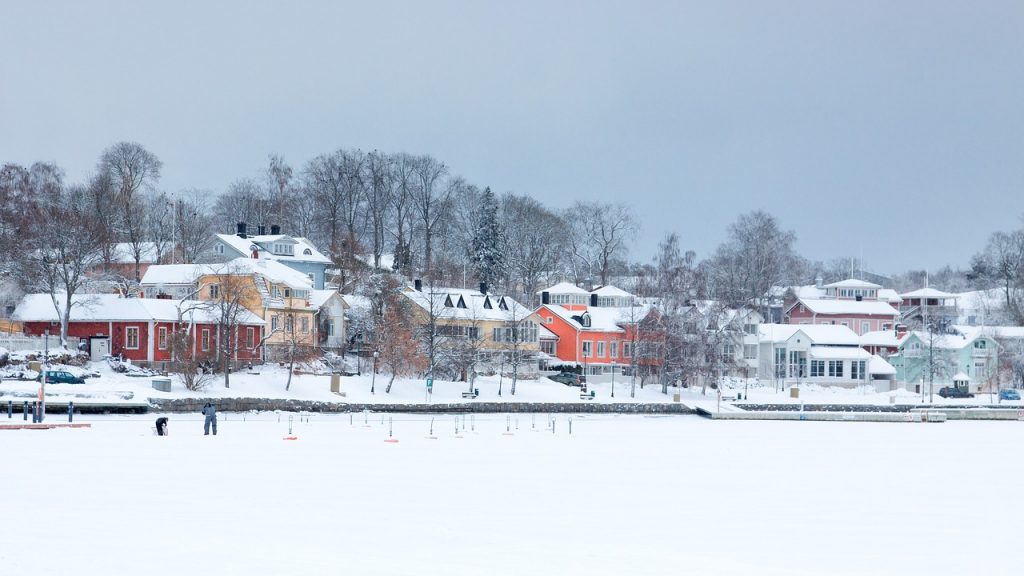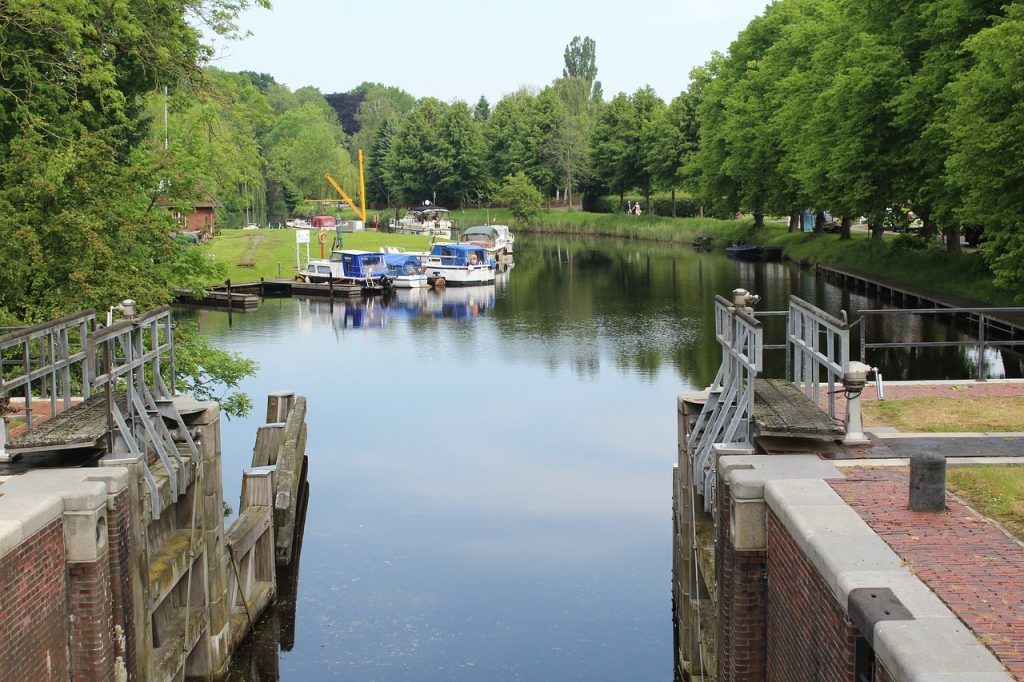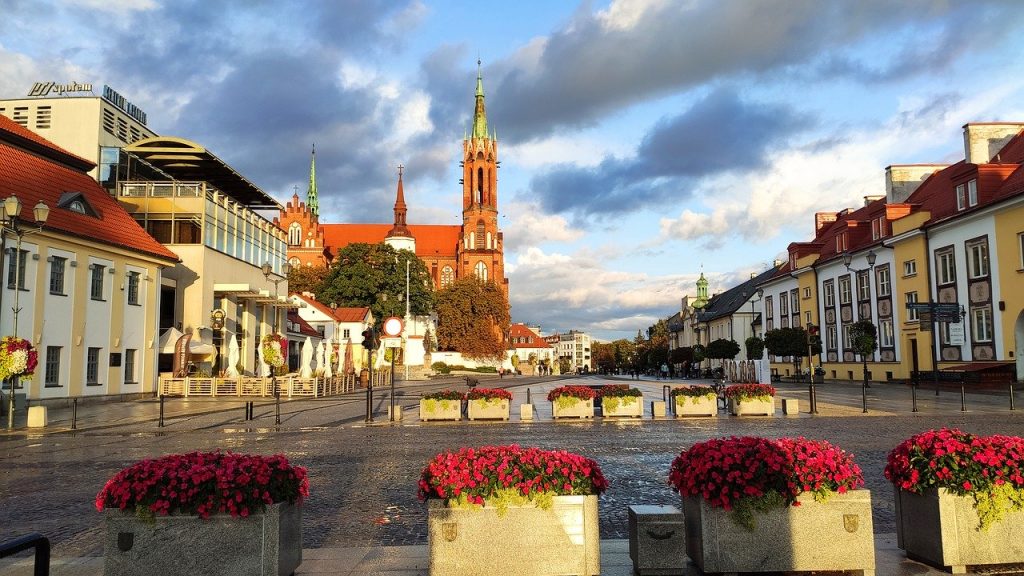The commune of Horodło is the easternmost commune in Poland, it lies between the arms of the Bug River, on the border of two historical lands – Polesie and Wołyń. It is located in the Hrubieszów poviat, in the south-eastern part of the Lublin voivodeship. The commune’s seat is Horodło – a place with a rich patriotic past. Two main roads lead to the commune: the provincial one running from Chełm to Zosin, and the national one from Zamość to Zosin. At a length of about 40 km, the commune of Horodło borders on Ukraine, this border is also the border of the European Union. In Zosin, we can cross the Polish border through the bridge over the Bug River and get to the border town of Uściłuża and then to Włodzimierz Wołyński.

History
The first mention of Horodło comes from 1287. However, excavations prove the existence of the stronghold from at least the 10th century. The stronghold in Horodło belonged to the historic Czerwień Castles, for which there were constant battles in the Middle Ages. As a consequence, these lands repeatedly passed from Polish to Ruthenian and Lithuanian hands. At the end of the fourteenth century, they became part of the Bełna feud of the Mazovian princes. In the first half of the fourteenth century, under the rule of the Lithuanian prince Lubart, a wooden castle was erected in place of the old castle in Horodło. in 1388 King Władysław Jagiełło granted Bełżyce together with Horodło to Prince Mazowiecki Ziemowit IV as the dowry of his sister Aleksandra. This granting was confirmed by a royal document in 1396 in which Horodło is already called the city.
On October 2, 1413, representatives of the most eminent Polish families headed by King Władysław Jagiełło and representatives of the main boyarian Lithuanian families together with the Grand Lithuanian prince Witold came to the castle in Horodło. Between the rulers, a Polish-Lithuanian union was signed, which strengthened Lithuania’s relationship with Poland, introduced the institution of the grand prince, the governors of voivods and castellans in Lithuania. The castle where King Jagiełło lived was destroyed in 1706 by the Swedes.
In 1454, Horodło received city rights, and in 1462. became the capital of the poviat and stronghold, existing until the end of the Polish-Lithuanian Commonwealth. In the 16th and 17th centuries, the city was plagued with fires and raids by foreign troops many times. In the years: 1500-1526, Horodło was destroyed five times by the Tatars, in the years: 1648, 1655, 1657, 1702 (then a destroyed castle, whose ruins existed until 1764) faced various foreign armies.
The greatest development of Horodło falls in the second half of the 16th century and the beginning of the 17th century. The favorable location at the crossing of the Bug and the intersection of old routes favored the flourishing of trade and craft. The development of Horodło was stopped by the wars of the second half of the 18th century. After the third partition, the lands of Horodel were incorporated into the Austrian partition, in 1809 to the Duchy of Warsaw, and from 1815 to the Kingdom of Poland.
On October 10, 1861, on the wave of political sentiment in the Kingdom of Poland, a huge manifestation of thousands of people of various states and denominations, who came here from various parts of the Commonwealth, took place near Horodło to celebrate the 448th anniversary of the Union of Horodel. The tsarist authorities did not let the demonstrators into Horodło, but this did not prevent them from gathering in the fields outside Horodło. Roman and Uniate clergy took part in the demonstration. In remembrance of these events a mound was erected and a wooden cross was erected. After the ceremonies, however, at the behest of the tsarist authorities, the mound was destroyed. In 1924 it was renovated and raised to 11 m. A metal cross was placed on it. The cross has the appearance of a cut tree trunk from which a new outgrowth grows in the form of a cross – it is a symbol of reborn Poland.
As part of the repression after the January Uprising in 1869, Horodło lost its municipal rights. The process of depopulation of the town with 3,200 inhabitants began in 1886, and in 1921 only 2,500. In the interwar period, Horodło was only the seat of the commune. During World War II, in 1939, the Polish Civic Guard was established in Horodło, followed by a cell of the armed struggle union, later transformed into the “AK” facility. After World War II, as a result of the extermination of Jews and the displacement of Ukrainian people, the town’s population dropped to 1,600. As of December 31, 2010 Horodło has 1062 inhabitants.
Tourist attractions
The commune’s attractiveness is determined by natural treasures and cultural assets that testify to the rich past of these areas. Nearly half of the area created in 1983 in Strzelecki Landscape Park is within the borders of the Horodło commune. South of Horodło is the Bug River Protected Landscape Area, created in 1997. A special place is Kacapka – an ecological site near Zosin, with a post-glacial, two-bottomed, natural mid-field lake, which is a habitat for numerous protected birds, and a place where you can find many animals and interesting steppe vegetation.
The agritourism values of these regions are given by the diverse relief of the Górka Horodelska area. An additional advantage is the Bug River, which has retained a natural riverbed with meanders and oxbow lakes, floodplains are overgrown with lush meadows. Unique vegetation from steppe and tundra communities, clean air and over 100 stork nests in the commune prove the ecological purity of this area.
Horodło commune is an attractive area, especially for tourists seeking rest in silence and contact with nature. The region’s asset is: the agricultural character of the town, low population density, no environmental pollution, a lot of forest areas, little changed landscape and cultural monuments.
In Horodło, the urban layout of the old town with a quadrangular market square and streets coming out of its corners has been preserved. In the park in the middle of the market, in the place where there once was the town hall, there are two statues of lions, which probably come from the equipment of the Horodel castle, which before 1939 stood next to the court in Wieniawka.
The parish church is located in the south-eastern corner of the market square. It is a post-Dominican temple of St. Jacek and MB Różańcowa, built in 1739-58 from the foundation of the horodel staroste Ambroży Strutyński. In 1411, on the initiative of Duchess Aleksandra, Ziemowit’s wife and Jagiełło’s sisters were brought to Horodło, for whom a wooden church and monastery were built in 1425. Both buildings burned down in 1500, set on fire by the Tatars. They were rebuilt in 1648, and then burned again this time by the Cossacks, before 1714 they were rebuilt again. In 1783, the parish was moved here from the demolished church, located near the banks of the Bug, which dates from 1744. Already as a parish, the church burned down in 1852. Two years later it was renovated. During World War I, it was damaged, renovated again in 1921. In 1783, the Austrian authorities canceled the Dominican Order, and the monastery buildings were demolished in 1845. The parish church is built in the late Baroque style, has a single nave with a presbytery facing south. Next to the church there is a wooden four-sided belfry from 1860 and the Chapel of Our Lady from the late nineteenth century. Next to the church there is a classicist presbytery built after 1845, using part of the walls of the former monastery demolished in 1845. The building is brick, ground floor with a break from front in the eastern part and a two-column porch.
In the south-west corner is the former Orthodox church of St. Nicholas, wooden, erected in 1932 in place of the previous, also wooden Greek Catholic from 1836. In the temple you can admire the magnificent 18th-century rococo iconostasis from Maciejów in Volhynia, renovated from reconstructed in 1998.
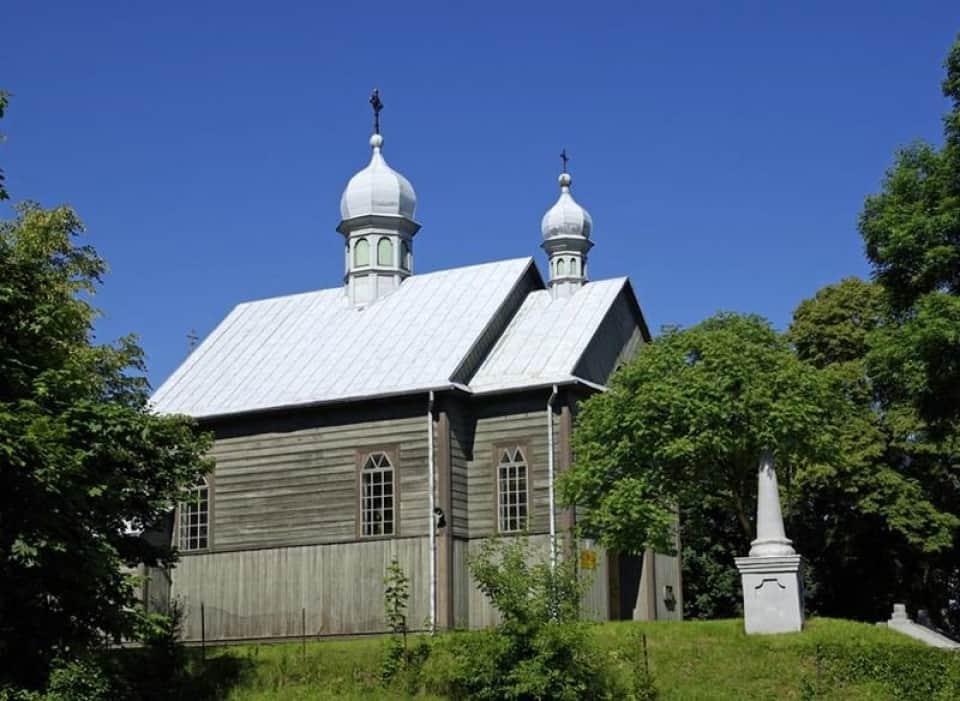
In Horodło there is also a wooden Polish Catholic church of Resurrection erected in 1933 and located among the cemetery. This confession was created in the USA at the end of the 19th century among Polish emigrants. The founder of the church was priest Franciszek Hodur, who in 1897 created the first parish in Scranton. In Poland, this denomination appeared in the early 1920s, it has about 50 thousand followers and over 90 parishes.
Approximately 1 km before entering Horodło, there is the Mound of the Union of Horodelsk erected in 1861 on the 448th anniversary of the signing of the Polish-Lithuanian Union, renovated and raised in 1924.
To the south-east of the market, on the Bug, there is a stronghold with the remains of the castle called the Jagiellonian Walls. Archaeological findings testify to the existence of the stronghold in this area already in the 10th-13th century. In the 14th century a wooden castle was erected on the site of the stronghold, which was repeatedly destroyed and rebuilt in various periods of history. This is where the act of the horodelian union was signed. From 1462, the castle was the seat of royal starostes. The castle was finally destroyed in 1702 by the Swedes.
About 2 km beyond Horodło in the direction of Zosin is Wieniawka with the remains of a manor complex, with a viewpoint on the Bug valley and a modernist modernist park from the mid-nineteenth century, to which a linden alley with several lime trees about 300 years old leads. The local estate was separated at the beginning of the 19th century, while earlier this area belonged to the royal property of Horodło eldership. After the partitions, the Austrian government took over the property and from 1799 it was in the hands of private owners.
In the village of Strzyżów located south of Horodło there is a late baroque palace built in 1762-86 by the will of Ludwika Honorata and Stanisław Lubomirski. After the fire, it was rebuilt by the Ożarowski family in 1836, obtaining some classical elements. The palace was also renovated at the beginning of the 19th century and in 1964. The palace is located on a slope sloping steeply towards the Bug river meadows. It has partly preserved the interior design with plafonds and fireplaces. On both sides of the palace there are original octagonal pavilions from the second half of the 18th century, the west housed the chapel, the eastern served as a lamus. In front of the palace there is a spherical lawn and a vast courtyard. On both sides there are ground floor outbuildings from the first half. Nineteenth century. After the war, the palace housed an outpost of the Border Protection Forces, and since the beginning of the 1960s after renovation it has belonged to the Strzyżów Sugar Factory. During the renovation, some elements of the old decor disappeared, but in many rooms you can still admire the Rococo stucco elements, which – apart from Łabuniek near Zamość – are no longer present in the Zamość region. The palace is two-storey, facing north. The central front projection was crowned with a triangular gable, in which the arms of Starzscy and Skarżyński-Lis and Bończa were placed, during this time this part of the manor was rebuilt.
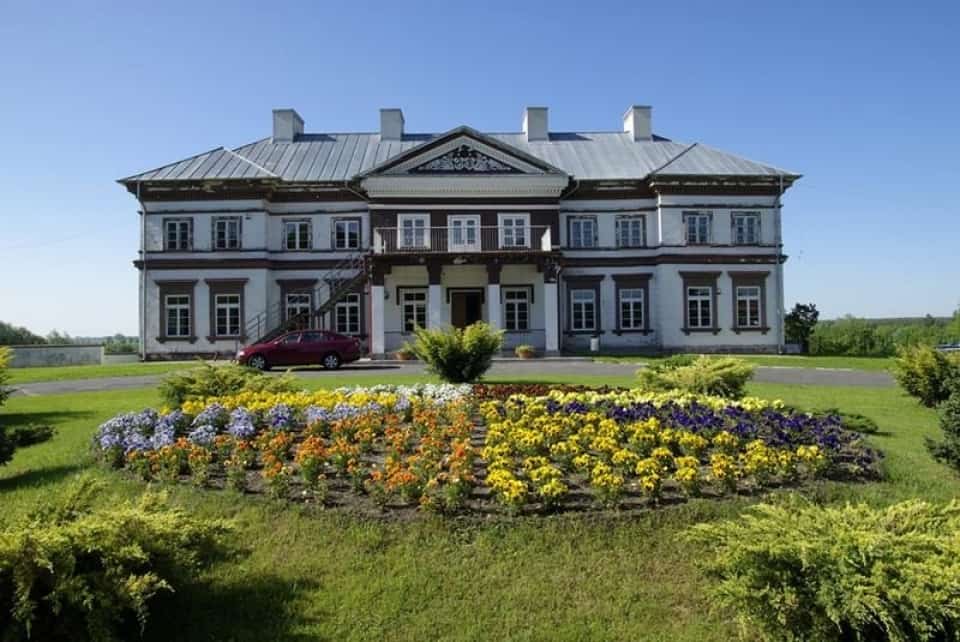
In Strzyżów it is also worth seeing the former wooden Uniate church of St. Nativity of the Blessed Virgin Mary from 1817, converted into an Orthodox church after the liquidation of the Uniate diocese of Chełm in 1875, and after 1947 rebuilt and used as a Roman Catholic church. Next to the church there is a wooden belfry from 1817 and a wooden presbytery from 1925.
In Strzyżów, you can also see a complex of sugar factory buildings with historic value. The company was founded in 1899 by Edward Chrzanowski from Morcz.
The article comes from the portal: http://www.horodlo.pl/
